Investigating the Mechanical Behavior and Energy Absorption Characteristics of Empty and Foam-Filled Glass/Epoxy Composite Sections under Lateral Indentation
Abstract
1. Introduction
2. Experimental Procedure
Materials and Methods
3. Results and Discussion
3.1. Effects of Tube Length
3.2. Effects of Polyurethane Foam
3.3. Effects of Tube Diameter
3.4. Effects of Tube Thickness
3.5. Effects of Indenter Diameter
4. Conclusions
Author Contributions
Funding
Institutional Review Board Statement
Informed Consent Statement
Data Availability Statement
Conflicts of Interest
References
- Kai, B.; Kaish, A.B.M.A.; Nordin, N. Concrete-Filled Prefabricated Cementitious Composite Tube (CFPCCT) under Axial Compression: Effect of Tube Wall Thickness. Materials 2022, 15, 8119. [Google Scholar] [CrossRef] [PubMed]
- Yuan, Z.; Zhong, K.; Wang, X.; Pan, X.; He, B.; Wu, J.; Zhang, J.; Xu, S. A Numerical Analysis on Lateral Resistance of Pile–Bucket Foundation for Offshore Wind Turbines. Appl. Sci. 2022, 12, 4734. [Google Scholar] [CrossRef]
- Taghizadeh, S.; Niknejad, A.; Macconi, L.; Concli, F. Mechanical Characterization of Novel Lightweight Bio and Bio-Inspired Sandwich Composites: Investigating the Impact of Geometrical Parameters and Reinforcement Techniques. Available online: https://ssrn.com/abstract=4857912 (accessed on 31 July 2024).
- Tan, X.; Zhu, M.; Liu, W. Experimental Study and Numerical Analysis of the Seismic Performance of Glass-Fiber Reinforced Plastic Tube Ultra-High Performance Concrete Composite Columns. Materials 2023, 16, 6941. [Google Scholar] [CrossRef] [PubMed]
- Sheini Dashtgoli, D.; Taghizadeh, S.; Macconi, L.; Concli, F. Comparative Analysis of Machine Learning Models for Predicting the Mechanical Behavior of Bio-Based Cellular Composite Sandwich Structures. Materials 2024, 17, 3493. [Google Scholar] [CrossRef] [PubMed]
- Rouzegar, J.; Niknejad, A.; Elahi, S.M. Experimental Investigation into the Energy Absorption of Composite-metal Tubes Subjected to Lateral Load. Iran J. Sci. Technol. Trans. Mech. Eng. 2020, 44, 585–598. [Google Scholar] [CrossRef]
- Gao, Y.; Guan, Y.; Li, K.; Liu, M.; Zhang, C.; Song, J. Failure behaviors of C/C composite tube under lateral compression loading. Nucl. Eng. Technol. 2019, 51, 1822–1827. [Google Scholar] [CrossRef]
- Wang, X.; Wang, Z.; Zhang, D.; Qian, K. Damage evolution and failure mechanism of 3D6d braided composite tubes under quasi-static lateral compression. Compos. Commun. 2024, 46, 101825. [Google Scholar] [CrossRef]
- Jalali, A.; Massumi, A. Effect of type of internal core on the behavior of diagrid tube systems under lateral seismic loads. Structures 2024, 63, 106464. [Google Scholar] [CrossRef]
- Sebaey, T.A.; Junaedi, H.; Alshahrani, H.; Alyamani, R.; Akkad, K. Effect of thermal aging on the crashworthiness of foam-filled CFRP composite tubes under lateral compression. J. Mater. Res. Technol. 2023, 23, 1–12. [Google Scholar] [CrossRef]
- Tao, M.-X.; Wang, Y.-L.; Zhao, J.-Z. Internal force redistribution caused by cracking of concrete in composite frame structures under lateral load. Eng. Struct. 2023, 283, 115876. [Google Scholar] [CrossRef]
- Zhang, B.; Peng, Y.; Zhang, S.; Lin, S.; Zhou, C.; Lin, G. Elliptical concrete-filled FRP tubes with an embedded H-shaped steel under axial compression and cyclic lateral loading: Experimental study and modeling. Compos. Struct. 2024, 330, 117839. [Google Scholar] [CrossRef]
- Li, Z.; Huang, Y.; Shen, Z.; Xu, H.; He, M. Lateral behavior of low-rise aluminum alloy frames infilled with composite wallboards. J. Build. Eng. 2024, 88, 109176. [Google Scholar] [CrossRef]
- Yang, X.; Liu, Y.; Wang, Y.-F.; Zhang, J. Performance of steel tube reinforced concrete-filled weathering steel tubular members under lateral impact loading. J. Constr. Steel Res. 2024, 213, 108382. [Google Scholar] [CrossRef]
- Niknejad, M.; Gohari, S.; Sadeghi, M.H. Mechanical Properties of Composite Tubes under Lateral Compression: Experimental Investigation and Numerical Analysis. Compos. Struct. 2013, 96, 247–255. [Google Scholar] [CrossRef]
- Moeinifard, M.; Liaghat, G.; Rahimi, G.; Talezadehlari, A.; Hadavinia, H. Experimental investigation on the energy absorption and contact force of unstiffened and grid-stiffened composite cylindrical shells under lateral compression. Compos. Struct. 2016, 152, 626–636. [Google Scholar] [CrossRef]
- Xia, Y.; Jiang, L.; Chen, Y.; Zhao, Y.; Yang, L.; Ge, D. Bidirectional-Reinforced Carbon Fiber/Polyether-Ether-Ketone Composite Thin-Walled Pipes via Pultrusion-Winding for On-Orbit Additive Manufacturing. Materials 2024, 17, 293. [Google Scholar] [CrossRef]
- Mahdi, E.S.; Kadi, H.E. Crushing behavior of laterally compressed composite elliptical tubes: Experiments and predictions using artificial neural networks. Compos. Struct. 2008, 83, 399–412. [Google Scholar] [CrossRef]
- Morris, E.; Olabi, A.G.; Hashmi, M.S.J. Analysis of nested tube type energy absorbers with different indenters and exterior constraints. Thin-Walled Struct. 2006, 44, 872–885. [Google Scholar] [CrossRef]
- Olabi, A.G.; Morris, E.; Hashmi, M.S.J.; Gilchrist, M.D. Optimized design of nested circular tube energy absorbers under lateral impact loading. Int. J. Mech. Sci. 2008, 50, 104–116. [Google Scholar] [CrossRef]
- Yan, L.; Chouw, N.; Jayaraman, K. Lateral crushing of empty and polyurethane-foam filled natural flax fabric reinforced epoxy composite tubes. Compos. Part B 2014, 63, 15–26. [Google Scholar] [CrossRef]
- Capretti, M.; Del Bianco, G.; Giammaria, V.; Boria, S. Natural Fibre and Hybrid Composite Thin-Walled Structures for Automotive Crashworthiness: A Review. Materials 2024, 17, 2246. [Google Scholar] [CrossRef] [PubMed]
- Zhang, J.; Zhang, M.; Liu, X.; Sun, Y. Structural behavior of steel tube reinforced resilient RAC shear walls under static cyclic loading. J. Build. Eng. 2024, 90, 109432. [Google Scholar] [CrossRef]
- Minsheng Guan, Xin Wang, Junlin Heng, Meng Sha, Hongbiao Du, Parametric study on lateral behaviour of composite shear walls with high-strength manufactured sand concrete. Structures 2023, 49, 332–344. [CrossRef]
- Zhang, B.; Peng, Y.; Gao, Y.; Wang, Y.; Chen, G.; Zhou, C.; Zhang, N. Seismic performance of elliptical FRP-concrete-steel tubular columns under combined axial load and reversed lateral load. Eng. Struct. 2023, 286, 116135. [Google Scholar] [CrossRef]

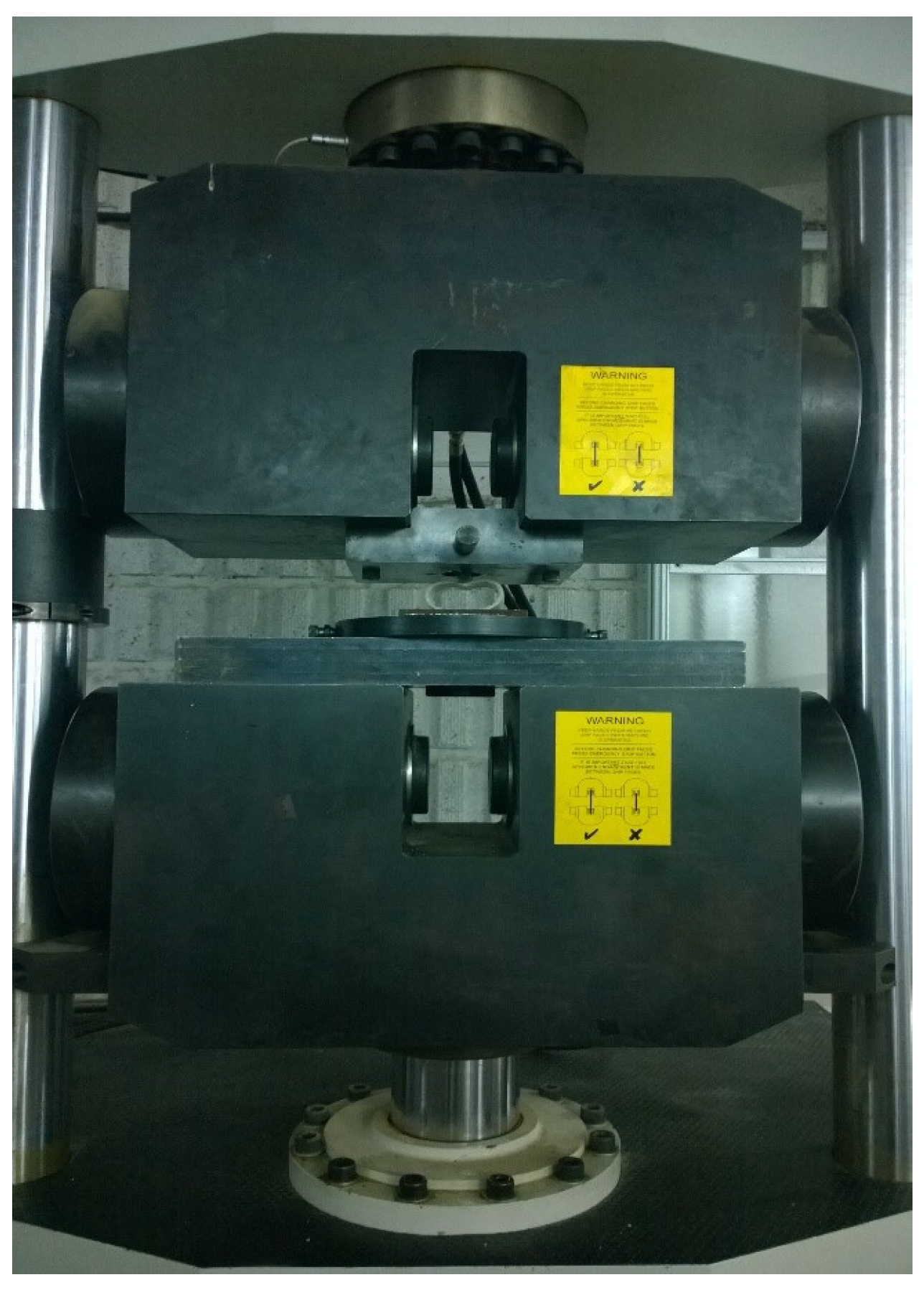
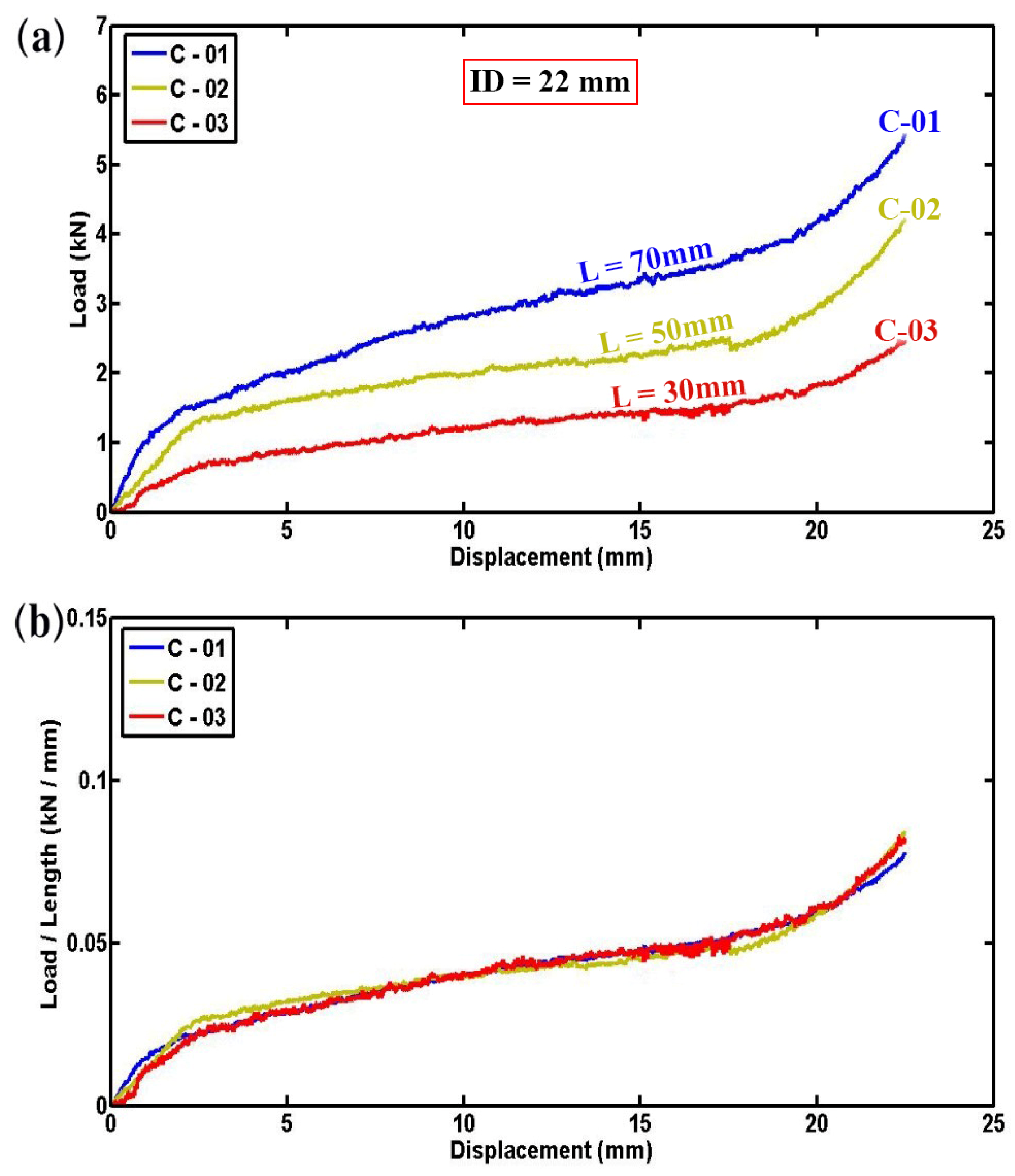

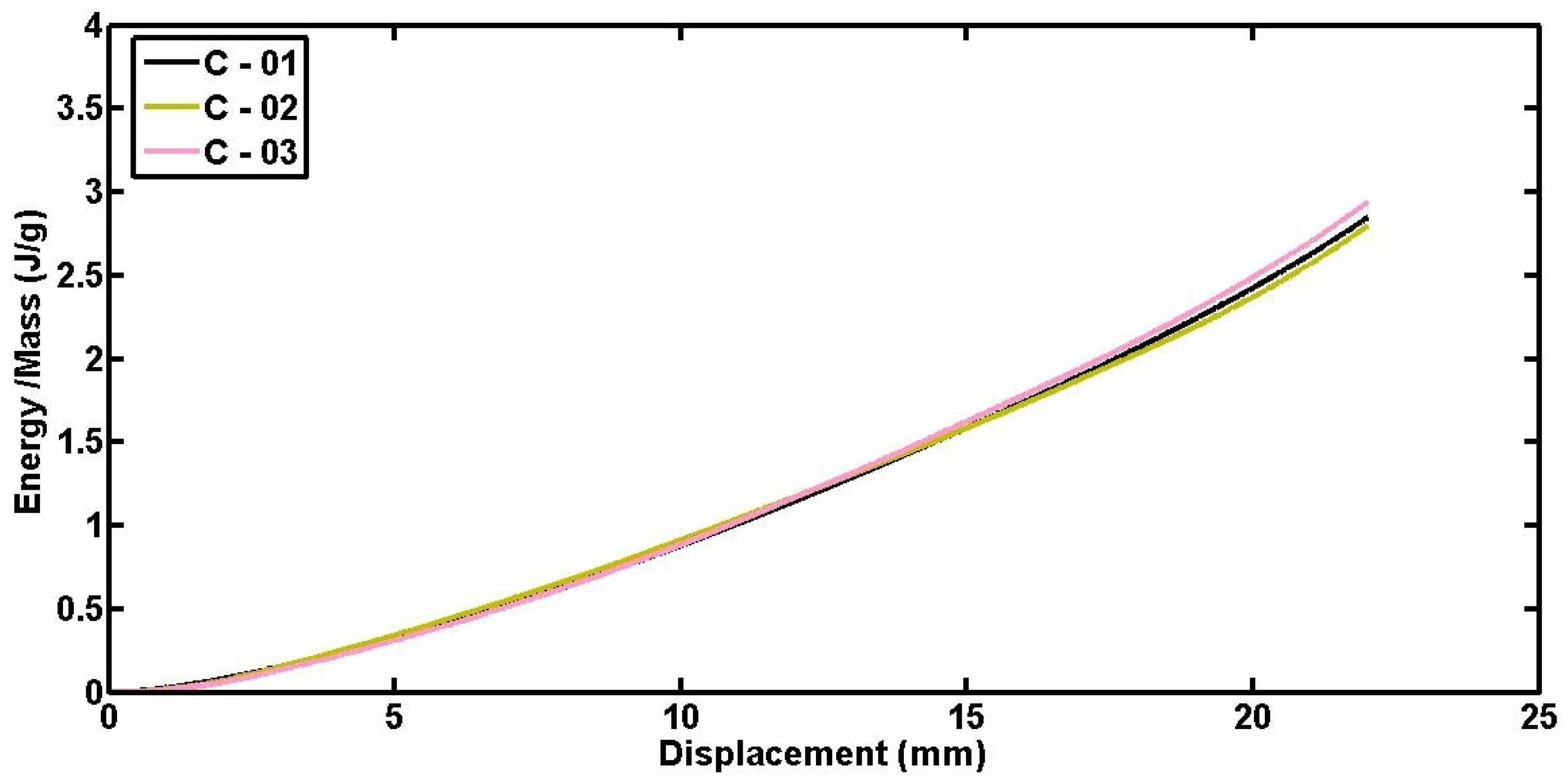



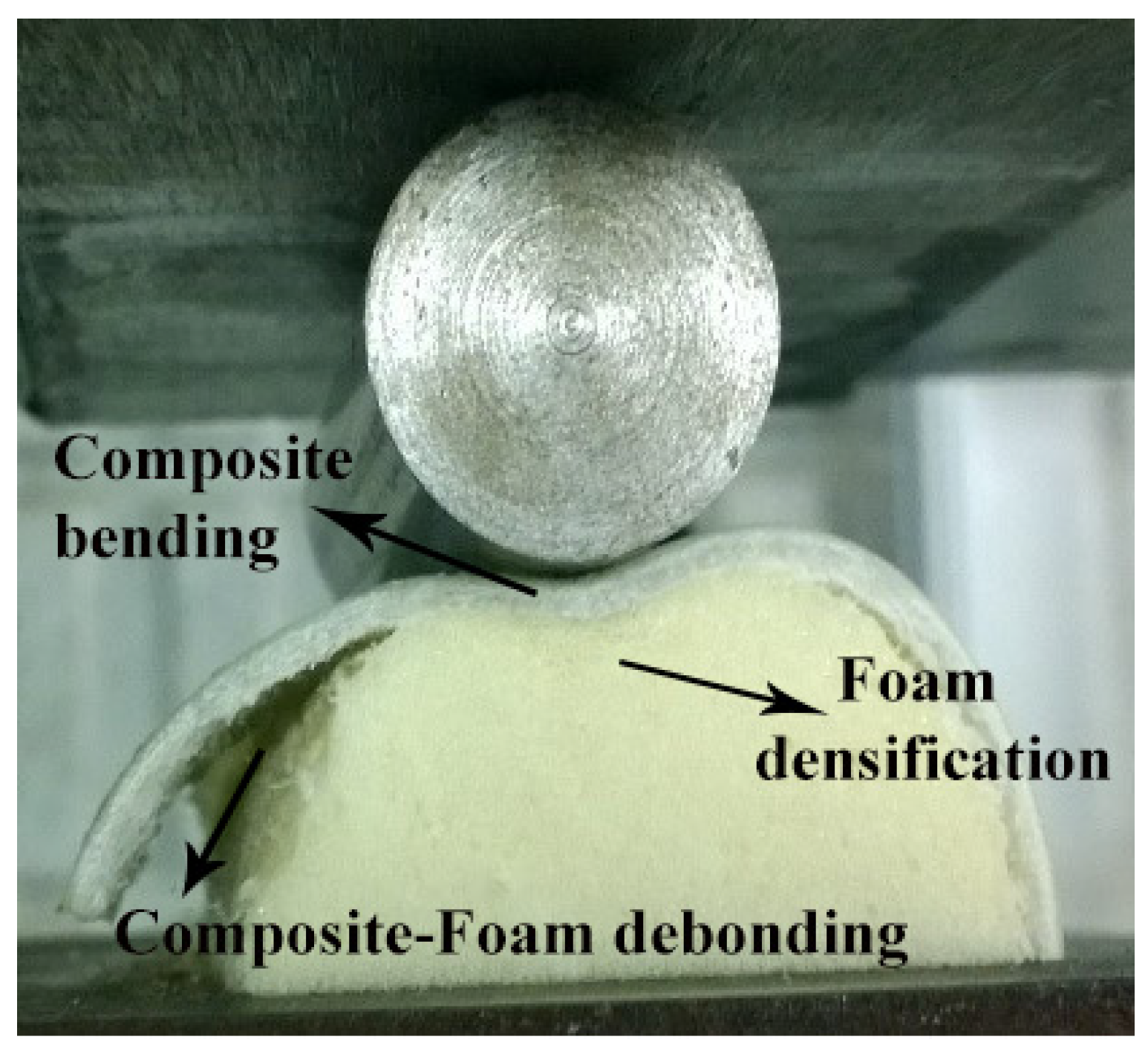
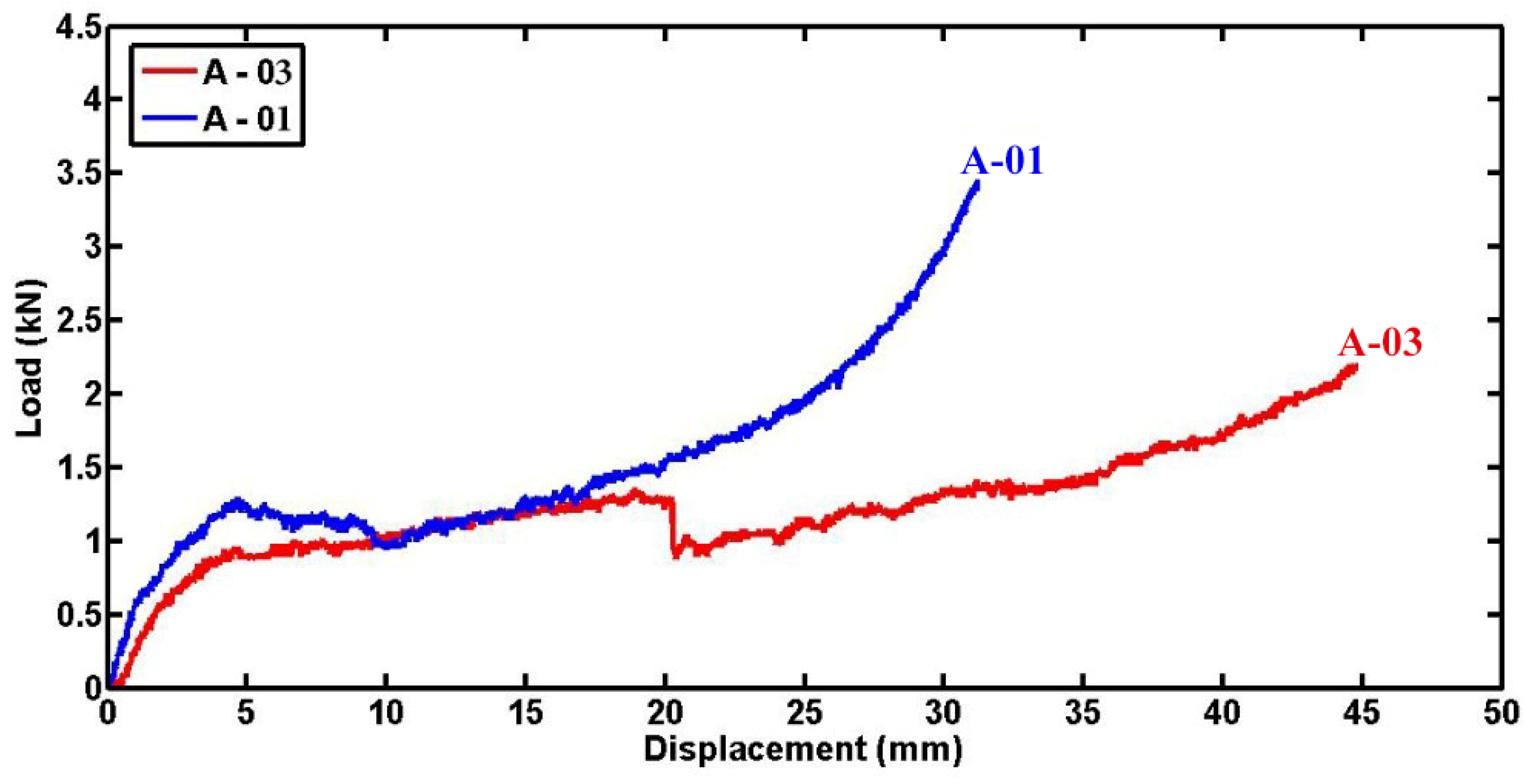
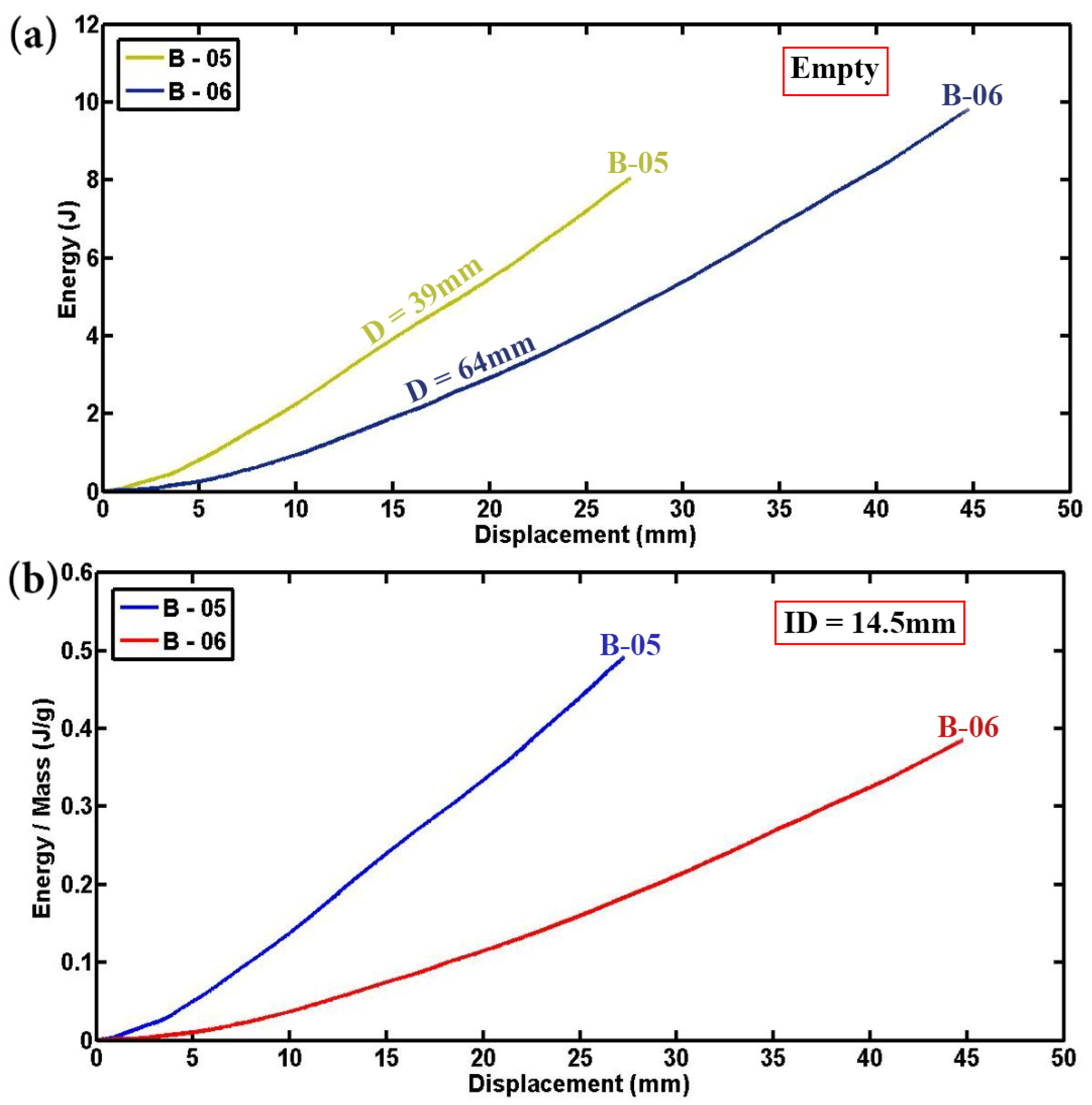

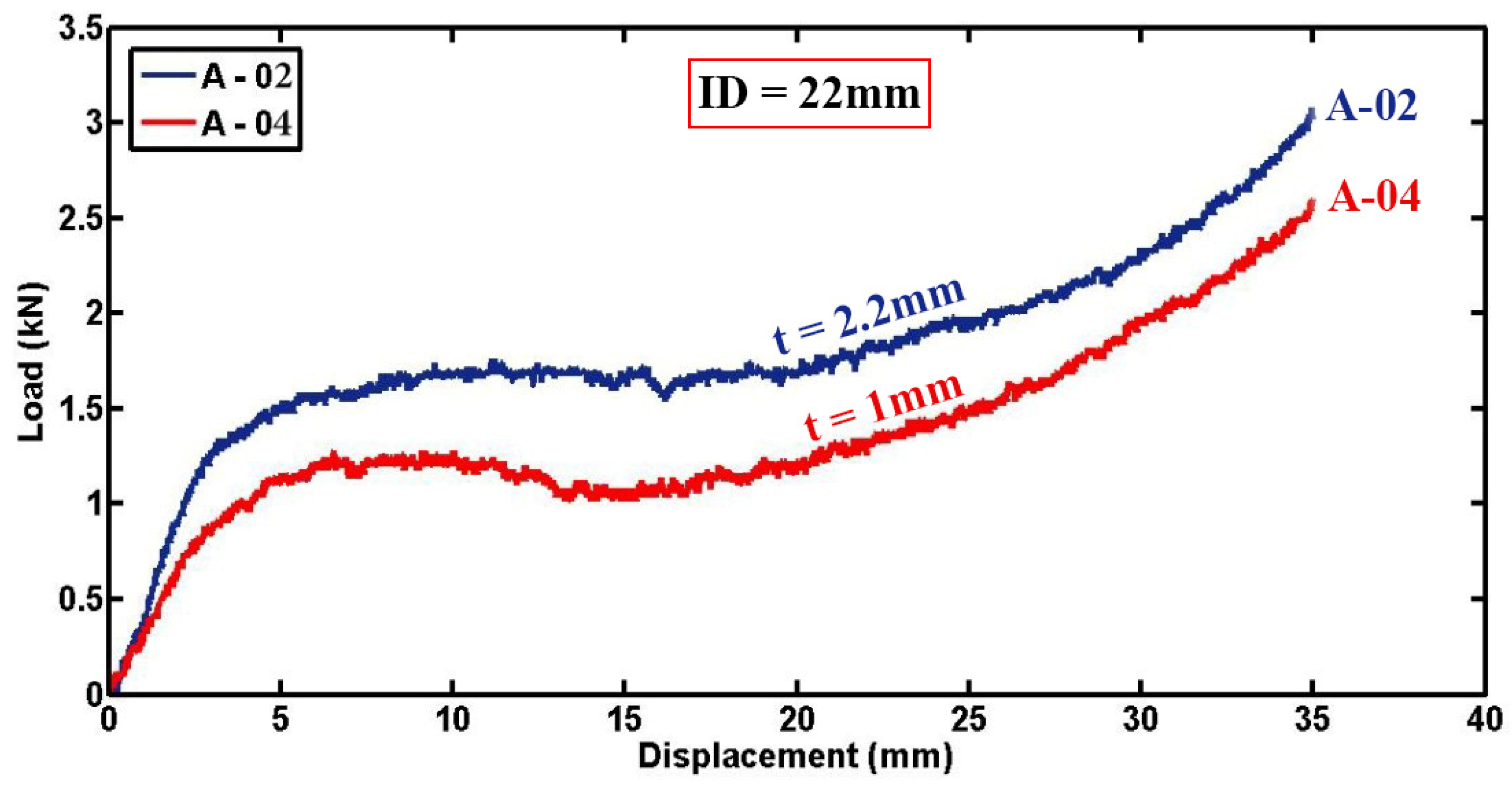

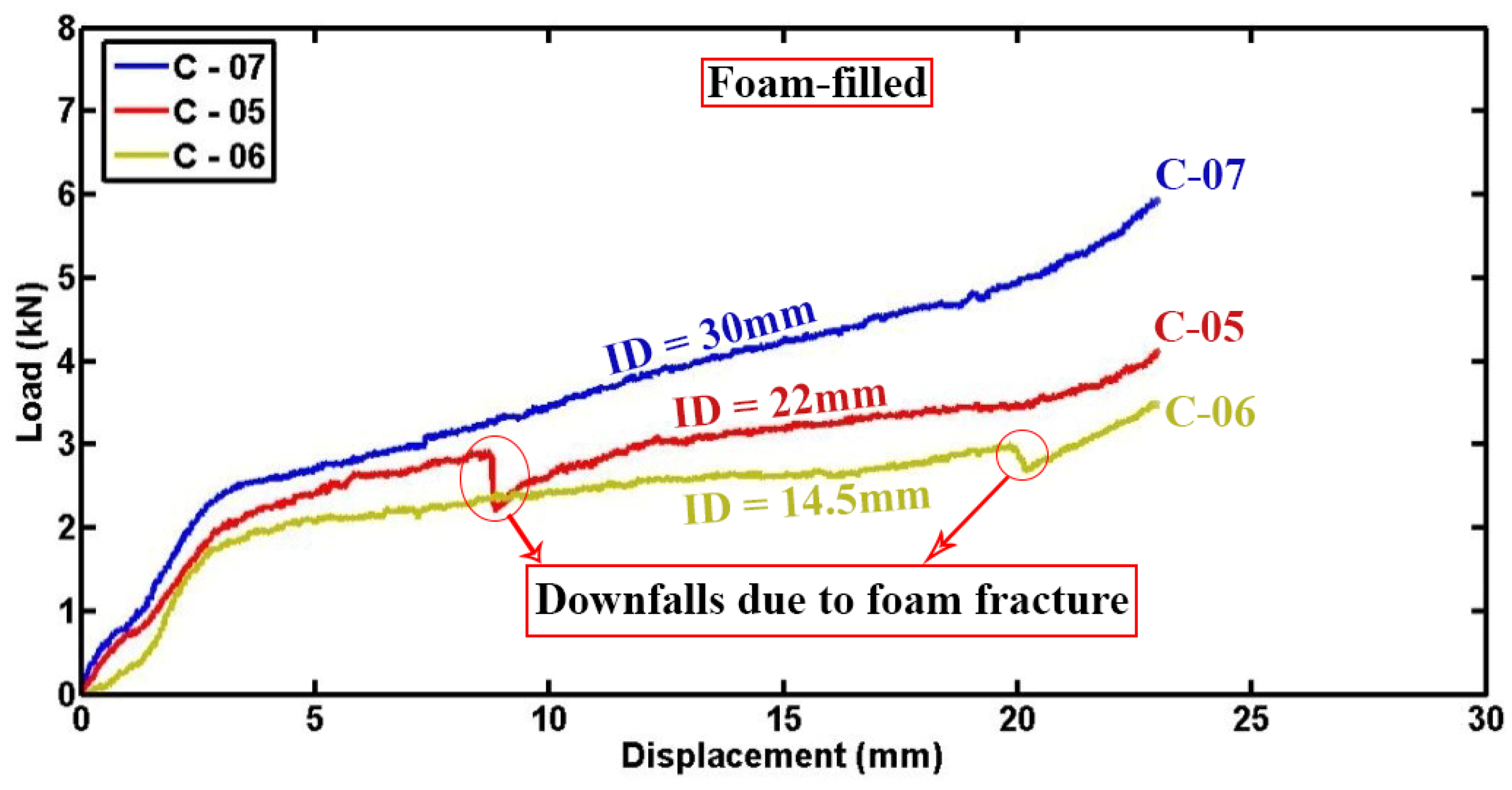

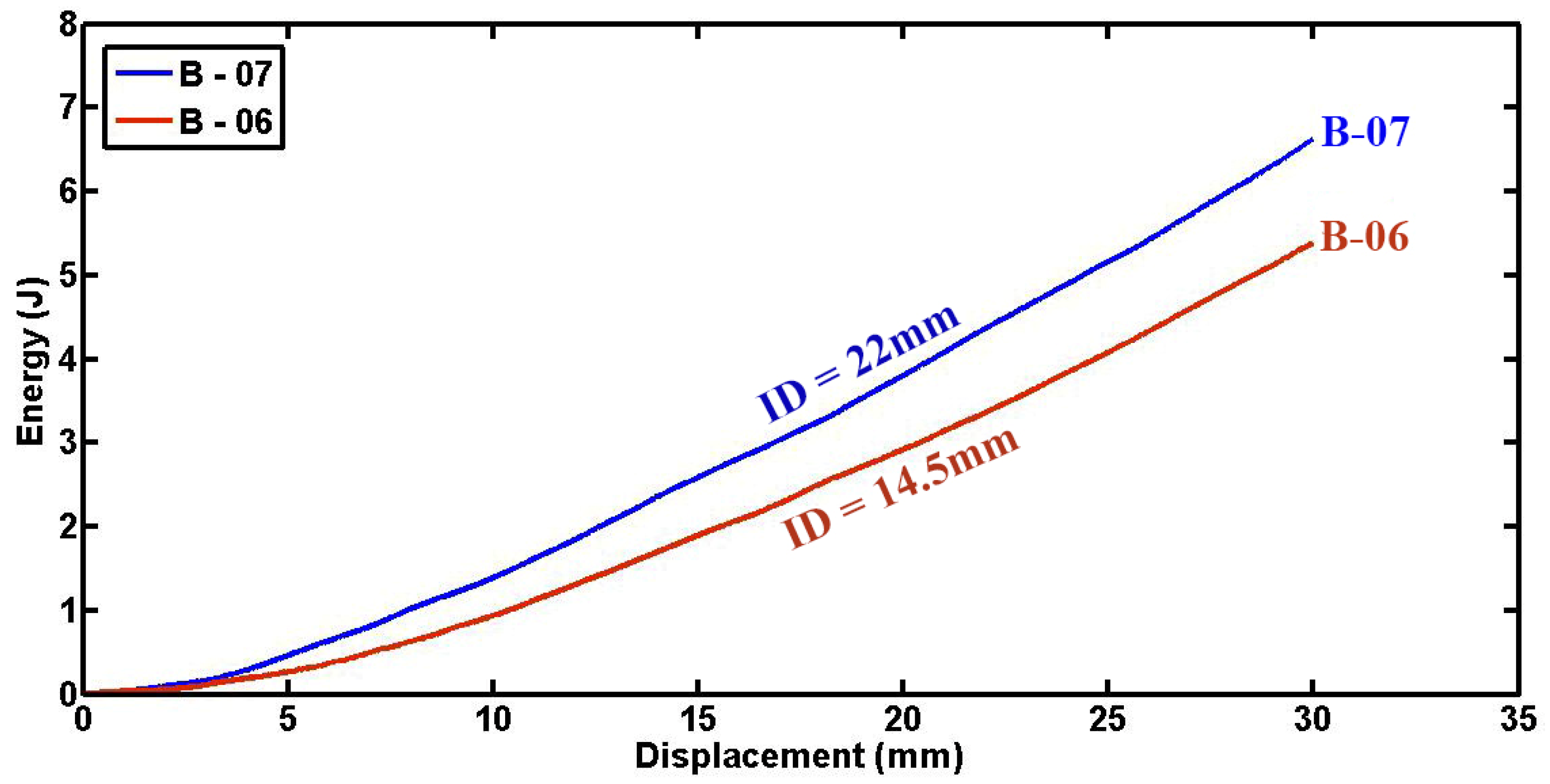


| Part No. | D (mm) | d (mm) | t (mm) | L (mm) | M (g) | ID (mm) | Tube Type |
|---|---|---|---|---|---|---|---|
| A-01 | 44.6 | 41 | 1.8 | 50 | 22.4 | 22 | Filled |
| A-02 | 54.4 | 50 | 2.2 | 50 | 37.74 | 22 | Filled |
| A-03 | 64 | 60.4 | 1.8 | 50 | 41.04 | 22 | Filled |
| A-04 | 54.4 | 52.4 | 1 | 50 | 27.8 | 22 | Filled |
| A-05 | 54.4 | 52.4 | 1 | 50 | 27.41 | 30 | Filled |
| B-01 | 54.4 | 50 | 2.2 | 70 | 40.34 | 14.5 | Empty |
| B-02 | 54.4 | 50 | 2.2 | 50 | 27.71 | 14.5 | Empty |
| B-03 | 54.4 | 50 | 2.2 | 30 | 17.38 | 14.5 | Empty |
| B-04 | 64 | 61.4 | 1.3 | 50 | 9.15 | 14.5 | Empty |
| B-05 | 39 | 35.4 | 1.8 | 50 | 16.35 | 14.5 | Empty |
| B-06 | 64 | 60.4 | 1.8 | 50 | 25.5 | 14.5 | Empty |
| B-07 | 64 | 60.4 | 1.8 | 50 | 25.55 | 22 | Empty |
| Part No. | D (mm) | d (mm) | t (mm) | L (mm) | M (g) | ID (mm) |
|---|---|---|---|---|---|---|
| C-01 | 64 | 61.4 | 1.3 | 70 | 21.84 | 22 |
| C-02 | 64 | 61.4 | 1.3 | 50 | 15.87 | 22 |
| C-03 | 64 | 61.4 | 1.3 | 30 | 9.03 | 22 |
| C-04 | 44.6 | 41 | 1.8 | 50 | 11.6 | 22 |
| C-05 | 64 | 60.4 | 1.8 | 50 | 32.88 | 22 |
| C-06 | 64 | 60.4 | 1.8 | 50 | 31.54 | 14.5 |
| C-07 | 64 | 60.4 | 1.8 | 50 | 31.84 | 30 |
Disclaimer/Publisher’s Note: The statements, opinions and data contained in all publications are solely those of the individual author(s) and contributor(s) and not of MDPI and/or the editor(s). MDPI and/or the editor(s) disclaim responsibility for any injury to people or property resulting from any ideas, methods, instructions or products referred to in the content. |
© 2024 by the authors. Licensee MDPI, Basel, Switzerland. This article is an open access article distributed under the terms and conditions of the Creative Commons Attribution (CC BY) license (https://creativecommons.org/licenses/by/4.0/).
Share and Cite
Taghizadeh, S.; Niknejad, A.; Maccioni, L.; Concli, F. Investigating the Mechanical Behavior and Energy Absorption Characteristics of Empty and Foam-Filled Glass/Epoxy Composite Sections under Lateral Indentation. Materials 2024, 17, 3847. https://doi.org/10.3390/ma17153847
Taghizadeh S, Niknejad A, Maccioni L, Concli F. Investigating the Mechanical Behavior and Energy Absorption Characteristics of Empty and Foam-Filled Glass/Epoxy Composite Sections under Lateral Indentation. Materials. 2024; 17(15):3847. https://doi.org/10.3390/ma17153847
Chicago/Turabian StyleTaghizadeh, Seyedahmad, Abbas Niknejad, Lorenzo Maccioni, and Franco Concli. 2024. "Investigating the Mechanical Behavior and Energy Absorption Characteristics of Empty and Foam-Filled Glass/Epoxy Composite Sections under Lateral Indentation" Materials 17, no. 15: 3847. https://doi.org/10.3390/ma17153847
APA StyleTaghizadeh, S., Niknejad, A., Maccioni, L., & Concli, F. (2024). Investigating the Mechanical Behavior and Energy Absorption Characteristics of Empty and Foam-Filled Glass/Epoxy Composite Sections under Lateral Indentation. Materials, 17(15), 3847. https://doi.org/10.3390/ma17153847








